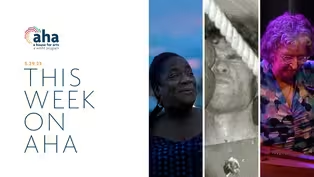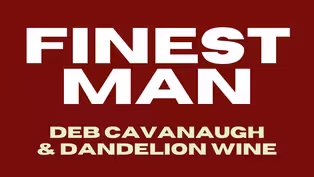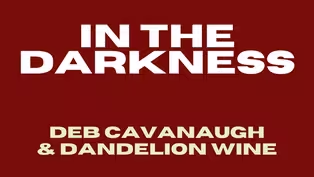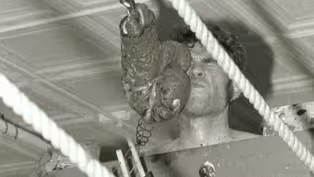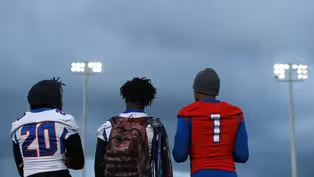
AHA! | 823
Season 8 Episode 23 | 27m 45sVideo has Closed Captions
Explore the lengths artists go to bring their vision to life.
Explore the lengths artists go to bring their vision to life, from Abraham Ferraro taking a punch from a mechanical boxing arm to Deb Cavanaugh and Dandelion Wine's celebration of the natural world through their unique "psychedelic folk" sound. Ira McKinley and Bhawin Suchak discuss their documentary "Outta The Muck".
Problems playing video? | Closed Captioning Feedback
Problems playing video? | Closed Captioning Feedback
AHA! A House for Arts is a local public television program presented by WMHT
Support provided by the New York State Council on the Arts (NYSCA), M&T Bank, the Leo Cox Beach Philanthropic Foundation, and is also provided by contributors to the WMHT Venture...

AHA! | 823
Season 8 Episode 23 | 27m 45sVideo has Closed Captions
Explore the lengths artists go to bring their vision to life, from Abraham Ferraro taking a punch from a mechanical boxing arm to Deb Cavanaugh and Dandelion Wine's celebration of the natural world through their unique "psychedelic folk" sound. Ira McKinley and Bhawin Suchak discuss their documentary "Outta The Muck".
Problems playing video? | Closed Captioning Feedback
How to Watch AHA! A House for Arts
AHA! A House for Arts is available to stream on pbs.org and the free PBS App, available on iPhone, Apple TV, Android TV, Android smartphones, Amazon Fire TV, Amazon Fire Tablet, Roku, Samsung Smart TV, and Vizio.
Providing Support for PBS.org
Learn Moreabout PBS online sponsorship- Experience the interactive performance installations of Abraham Ferraro Filmmakers, IRA McKinley and Bhawin Suchak discuss their documentary out of the muck and catch a performance from Deb Cavanaugh and Dandelion wine.
It's all ahead on this episode of aha.
A House - For Arts - Funding for AHA has been provided by your contribution and by contributions to the W M H T Venture Fund Contributors include the Leo Cox Beach Philanthropic Foundation, Chet and Karen Opalka, Robert and Doris Ficsher Malesardi and the Robison Family Foundation.
- At M&T Bank, we understand that the vitality of our communities is crucial to our continued success.
That's why we take an active role in our community.
M&T Bank is pleased to support W M H T programming that highlights the arts and we invite you to do the same.
- Hi I'm Jade Warrick and this is aha.
A house for art, a place for all things creative.
Here's Matt Rakowitz with today's studio visit.
- I'm in Albany, New York, about to look at the installations and performances of Abraham Ferraro.
Let's go.
- My artwork has always been about art itself and what it's like to be an artist.
I do large scale installations where I have a bunch of light switches and literally miles of extension cords and they light up art and not art signs.
I've done performance work where there're literally tons of steel and wood and there are these really laborious projects that boil down to the creation of a piece of artwork, like a drawing or painting.
I also make work that's more on the craftier side.
I do these orbs that are incredibly detailed.
I mean, I even consider house renovations to be artwork.
This is the flavor space saver Black beans.
I like to do anything that unites hands-on skill with creative thought.
When I was making artwork in graduate school I was making these pieces that involved a lot of interaction with the viewer and at a certain point it became obvious to me that the pieces were successful when I was around demonstrating them.
So it became very obvious that I needed to be around and do a performance.
And so the very first one that I was working on was the knockout artist And it was a spring loaded mechanical boxing arm.
And originally I thought, wouldn't it be great if it came to my art show?
And there was this spring loaded mechanical boxing arm that would threaten to punch you in the face as you walk by.
Well, obviously cause legal reasons.
That was a terrible idea.
So then it became a natural that I was gonna be the one who was gonna get punched in the face by this spring loaded mechanical arm.
And during the act of that there would be these paintbrushes that would dangle below the boxing glove and they would strike a canvas just as I was being punched in the face.
And then over a 12 round match I would create this abstract action painter.
The boxing glove is actually left-handed.
And then, so it's my alter ego.
The knockout artist is essentially me.
A lot of my work is autobiographical.
When you're making artwork, you're always like in the process of of beating yourself up you are trying to create artwork.
You're debating on whether or not it's good art or bad art or if it's art at all, are people gonna like it?
So you're always in in competition with yourself.
The stationary climber was a 15 foot tall climbing tread wall.
I would have these cables and employees hooked up to my arms.
And so that would go back to a drawing table and it would pull a marker in the X or Y coordinate.
And as I climbed the tread wall, the tread wall was connected to its drawing table and it would spin the drawing table in circles.
It would also push the climbing jig from the center of the circle to the outside of the circle.
So you have these four different movements that would make this scribble line draw.
The performance pieces, a lot of them were actually really difficult to make and I was really kind of jealous about painters and photographers that could just send their artwork to gallery and they would get installed for them.
I mean, you know, with the performance work, it was always me setting up these pieces and it was really hard to sustain.
People look at the knock art artists and they're thinking oh, that's really abusive.
And why would you do that to yourself?
Well, I mean, that was the easy part.
- So I was struggling and I was doing these really strenuous laborious performances and the end, you really only have this tiny little drawing to show for The Melbourne artwork directions was really an answer to the problem that I had created with my performance pieces.
I really wanted a piece of artwork that was lightweight and easy to transport.
Originally started in 2008 when I got into a show in Scotland.
It was called In Transit.
And it was all about how artwork gets from A to B.
And so I thought, oh, I'll just make a funny looking box with holes in it and mail it to Scotland and they'll take it right off the the delivery truck and put it on a pedestal and that's your piece.
And I thought everyone was gonna do that, right?
So I went to go check out the show online and to my surprise, no one else had done anything like that.
And that's when I had that that eureka moment, I'm like, huh, I'm onto something here.
It wasn't long before I figured out how to make a bunch of pieces interconnect and turn into this monstrosity that has become now.
I, I definitely am compelled to make artwork.
I really need to build things.
It is definitely the thing that has defined my life without the ability to create something my life would definitely be not as full.
The Lightfoot series are really about the myth of creation.
Like who really declares what is art.
I can say that it's art, but if it's not validated by the art institutions or by the art audience, then doesn't it really matter?
- Out of the Muck is a documentary by IRA McKinley and Bhawin Suchak.
The film presents a portrait of the Dean family longtime residents of the historic town of Pa Hokie, Florida, as they resist despair with love and forced their own unique narrative of black achievement.
I sat down with the filmmakers to discuss the film ahead of an upcoming screening at the Albany Film Festival.
- Perfect.
- Welcome.
IRA and Bhawin to a House for Arts Today.
I'm really excited to talk to you guys about your film Out of the Muck.
One of the first things I wanna dive in before we get too into the nitty gritty with the film is how did you both meet?
- Well, that, that's, that's amazing.
I came from out of North Hampton where I just was producer here for community television, came back to Albany and I wanted to do some projects and Bow was just starting his youth effects program and somebody said, well, you need to meet Bowen and you guys can work some things out.
Cause I had a project that was in mind.
This is, this was like right before the Occupy movement started so we're talking about 2009, 2010.
He had the equipment where I didn't you know what I'm saying?
I had the knowledge and story that I wanted to tell and know how to use some of the cameras but not as advanced as Bhawin was.
So I saw him out - I've been making short documentaries.
I'd made one feature at that point, but for me it was really how committed he was about the story and passionate he was.
That was like, okay, I I, I'm definitely gonna be, you know you know someone that's gonna support and help you.
And then as the project evolved we became co-directors and then we met Sam Pollard who became our executive producer on that project.
Then it was kind of off to the races.
And that was our first film the Throwaways that we finished in 2014.
- And let's talk a little bit more about your current your most recent film out of the Muck.
What role did each of you play within it?
Because your co-directors, right?
So what did IRA do and what did Bhawin do?
Yeah - Well, I mean, I'll, I'll I'll start by just saying, I mean my main role was to help bring this vision to life.
You know, IRA had a very clear story of what he wanted to, to tell.
Now he had to take the time to go and develop you know, the, the, the details of that his family members connecting with the community.
And he'll talk a little bit about that.
But my role was really trying to think about, you know, how how do we want to film this story?
How do we want to tell this story in a way that is cinematic but also is unique to the environment of Pahokee Florida, which is not like any other place in the world, in my opinion.
And so bringing those elements of, you know how do we get, you know, the certain kinds of shots like what kinds of pacing will we have for the story?
What kinds of, you know, additional, you know crew where we need.
So it was kind of like that role playing more like the technical and the, you know, the the visual and the aesthetic element.
Bringing that into it.
- Yeah.
So what is, what is the story and the focal point of outta the muck?
- I think it's generational of how they help each other and going through all these hard times.
They still surviving in the poorest county.
They're, they're in this county called Palm Beach and 40 miles to the East when you land down there, there's Trump, there's Mar-a-Lago and there's all these rich people.
Then you go 40 miles to the West and there's there's sugar, you, us sugar and these poor.
Now you keep these people poor to produce this wealth.
So one of the things we say out of the muck how do you get out of it?
You know what I'm saying?
So you have this generational of people coming together regardless of the, you know the circumstances, you know what I'm saying?
And that's, I think that we wanted to base off and touch on the history.
- It's beautiful.
I know it's probably a little challenging when you go into communities, particular small communities with filming.
You know, sometimes filmmakers go in and they just wanna go in and they wanna film and there's kind of a disregard historically.
And I want to know your two, both of your approaches to going into this community and filming and how did you get the folks who are on camera to be involved?
And did you face any challenges with that?
- Yeah, I mean, I'll, I'll say that the number one thing and this is for every project that's a longer form project is to start by building the relationships, you know and connecting with the people.
And I think obviously this is Iris family so he has those connections, but he still hadn't been there as you see in the film for 30 years.
There's people he had never met till 2015 when he started doing the research.
So for us, if you think about the first in time that IRA went down and engaged with his family, that was January, 2015.
We really didn't start rolling on this film camera till September of 2016.
We had gone down in the fall of 2015.
We had cameras, we were filming some people we were mainly filming the landscape.
So I could capture like, okay what is the kind of color palette?
What is the kind of, the ways that the light is hidden stuff as a cinematographer thinking about those things.
But for me it's like I had to build those relationships with people because you know, you can't just go in a place and expect people to be comfortable with you filming them unless they know who you are and what your purpose and intention is.
And I think in Pahokee, if you've done any, you know kind of research on that town, you'll notice a lot of documentaries have been made about this little town.
And what do they focus on?
The poverty, the violence, you know, all about people leaving the town and the football team.
And it's like people get kind of tired of only being seen in one light.
And as IRA just said, I mean for us, we wanted to focus on the intergenerational beauty of how people live together help each other, you know, focus on people like Bridget who have been there for her whole life.
And Iris family has been there for seven generations.
That's rare.
We don't hear about those stories.
So it was kind of like an attempt to to to have a counter narrative to what you traditionally see about those types of towns.
But the number one thing starting point was building relationships because it took time.
And there's people that still would see us, what are you guys doing with that camera?
You know, who you filming?
And I think the football players and the young people they love being on camera.
So they were really into it because they were like, oh, you're I want to be on camera, like film me.
You know, they want to kind of show out for that.
But a lot of the folks who, you know had been there, they know, they know how some of these films have been exploiting them and their community and they said, we wanna be, you know aware of what you're doing.
Even once we started rolling and like really filming we still took time.
Like there was times people would be like can you stop filming?
Absolutely.
I cut the camera off and put it down.
Cause I'm like, I'm not gonna film you if you're uncomfortable with me filming you.
And I think a lot of those filmmaking teams that have been in there have been predominantly white documentary filmmakers who are trying to extract these negative stories.
So they saw IRA and even though he was from there they still had to ask him questions.
But then once they realized who his parents were and who his father was specifically, and Oh you Bridget's uncle.
Oh, okay.
You know, Alvin, that's how you build the relationships.
But it took, it took time - When, when I first talked to 'em, I said, yo, listen this is gonna take three to four years.
We didn't know it was gonna take seven.
We had like three to four years we're gonna be coming down here filming.
And they didn't know the process.
I said, all we need is access to your life.
You gotta feel comfortable with that.
Yes you do.
You know what am I saying?
And they haven't seen me for 30 years.
So they had to get comfortable with me.
They had to get comfortable with violent violent part of the family.
He, he's brought all his family down there, they, they and they love them too.
So they're comfortable.
So when the people that you bring to shoot, you know and the people that you're shooting have to be comfortable with the process.
One time we had no money, heat, and they fed us.
- We were no funding yet that - First year.
- Yeah.
So Iris family came through, they were housing us feeding us the whole time.
- So what were folks' reaction?
Like, it seems like a team effort.
So what were people's reactions once they saw the screening?
Yeah - I mean, I mean, I'll just say that one time that we did a well, we've done a bunch of community screenings, especially for the family.
We screened it a lot of times.
But we did one big community screening and it was great.
I mean, people who had never seen the film, never, some of them didn't even know we were filming the whole time.
- There was the history - That was the history piece.
And that was a part that was amazing to me cuz I was like really blown away by people who live in a town and don't even know how significant that town is to the history of the entire country.
And they were blown away by that.
They loved seeing themselves on camera.
I think a lot of feedback where people were like we love that there's many generations represented here.
It's not just about high school kids or elders or any, it's specifically about how the community is all these different generations.
You got babies all the way up to people who are in their late nineties.
Yes.
And that was something that they felt proud about because that's what Pahooke is about.
You know, people look out for each other, you know so the community screenings were a lot of fun, you know I think the the biggest feedback was like you were saying they're like, when is this thing coming out?
Like, we wanna watch it, we wanna share it with people.
- Hi Max.
- You know, but, and that's part of the process when you do a film.
It's like people don't understand how long it takes.
And then of course, you know, because we were working with PBS, we have to work under their constraints and also their kind of, you know, deliverable schedules.
So it was a process for them.
But I think in the end, you know, people have been very positive.
And I think part of it is because it was something that they had not seen before, that they were dying to see a film that talked about their community in a positive way.
- Without being all sound bites.
- Right.
Right.
Yes.
And I mean, you look at it, the town when I was there in the sixties and seventies it was white and then now it's not.
But it's like every town, in USA were, and and the thing is, is like more Poplar is a small town than there's really nothing there.
You know what I'm saying?
They used to have, you know, burger King, hospitals stuff like that, that's not there anymore.
You know what I'm saying?
And there's a whole generation that never knew that they had this type of stuff going on.
You know what I'm saying?
Before all this stuff got scooted out but the thing to me is the resource.
And you see that people eat, they fish, you know they catch, they catch rabbits, they do all these things.
So it's not just even though they pour their, their, they're they're rich and the resources.
- Yeah.
- Bridget has a mango tree in front yard and two avocados and a me banana tree, next door in their backyard, next door they have a orange tree.
And what we wanted to show was a place that was to me like a gardened meeting, you know?
- Oh, that's beautiful.
- Without all, well I all the, you know, the technology stuff you know what I'm saying?
So they broke it down, but they're still survival.
- Take us back to our roots.
Right.
There you go.
Well, awesome.
Well, I appreciate you guys taking the time to talk.
I hope folks see out of the muck.
It's an amazing film and I can't wait to see what you guys do together next.
out of the Muck is screening at the Albany Film Festival at 1:00 PM on Saturday, April 1st.
And it's free and open to the public.
Go to Albany film festival.org to learn more.
You can also watch the film right here on W M H T on Monday April 3rd at 10:00 PM Please welcome Deb Cavanaugh and Dandelion Wine.
(instruments being played) - I went down to the corner looking for some fun.
I went down to the corner.
I was looking for some fun.
And when I saw you there, ooh, I was all you walked up and asked me would I go for a ride?
Yes.
He walked right up and asked me if I go for a ride.
And then the next thing I knew I was sitting right by your side.
I don't know what you did.
I don't know what you said.
I looked in your eyes now as outta my head.
- Woo - Me, baby.
Do you know what I mean?
We're the finest man that I have ever seen.
I don't know what you did.
I don't know what you said.
I looked in your eyes now out my head.
Oh, baby!
Do you know what I mean?
We are the finest man that I have ever seen you cracked up from behind.
Can you slap me off my feet?
Oh yes you did.
You crapped up from behind and you slapped me right off my feet.
And when you lay me down, Ooh.
Yes.
It felt so sweet.
I don't know what you did.
I don't know what you said.
I looked in your eyes and I was put of my head was crazy.
Oh, tell me.
Do you know what I mean?
We are the finest man.
I said, you are the finest man.
Ooh.
Yes.
You are the finest man that I've ever seen.
(instruments being played) There are times in my life when I need stay ness Take a break from the noise and the crowd when the leaves are dying and the air is chill and the darkness tries to wrap me in a shroud.
Come with me.
I want you by my side in the darkness.
We can shine.
Come with me together one more time in the darkness.
Oh, we can shine - on the day of the dead.
I will remember all those souls who have gone on ahead.
- When the leaves are blowing and the air is chill and the darkness tries to get inside my head with, I want you by my side in the darkness.
Oh, we can shine.
Come with me together one more time in the darkness.
Oh, we can shine later in my life, I hope.
I notice that my life wasn't wasted in the end when the leaves are frosty and the air is chill and the darkness lies in waiting.
We can shine come with me together one more time in the darkness.
We can shine.
- Thanks for joining us.
For more arts, visit w ht.org/aha and be sure to connect with us on social.
I'm Jade work.
Thanks for watching.
- Funding for AHA has been provided by your contribution and by contributions to the W M H T Venture Fund Contributors include the Leo Cox Beach Philanthropic Foundation, Chet and Karen Opalka.
Robert and Doris Ficsher Malesardi, and the Robison Family Foundation.
- At M&T Bank, we understand that the vitality of our communities is crucial to our continued success.
That's why we take an active role in our community.
M&T Bank is pleased to support W M H T programming that highlights the arts and we invite you to do the same.
Video has Closed Captions
Preview: S8 Ep23 | 30s | Explore the lengths artists go to bring their vision to life. (30s)
Deb Cavanaugh & Dandelion Wine "Finest Man"
Video has Closed Captions
Clip: S8 Ep23 | 3m 12s | Deb Cavanaugh and Dandelion Wine share their unique "psychedelic folk" sound. (3m 12s)
Deb Cavanaugh & Dandelion Wine "In The Darkness"
Video has Closed Captions
Clip: S8 Ep23 | 3m 54s | Deb Cavanaugh and Dandelion Wine share their unique "psychedelic folk" sound. (3m 54s)
The Punch That Inspired an Artist
Video has Closed Captions
Clip: S8 Ep23 | 6m 48s | Artist Abraham Ferraro takes a punch from a mechanical boxing arm for his vision. (6m 48s)
Telling the Stories of Black Achievement in "Outta The Muck"
Video has Closed Captions
Clip: S8 Ep23 | 10m 51s | Ira McKinley and Bhawin Suchak discuss their documentary Outta The Muck. (10m 51s)
Providing Support for PBS.org
Learn Moreabout PBS online sponsorshipSupport for PBS provided by:
AHA! A House for Arts is a local public television program presented by WMHT
Support provided by the New York State Council on the Arts (NYSCA), M&T Bank, the Leo Cox Beach Philanthropic Foundation, and is also provided by contributors to the WMHT Venture...
